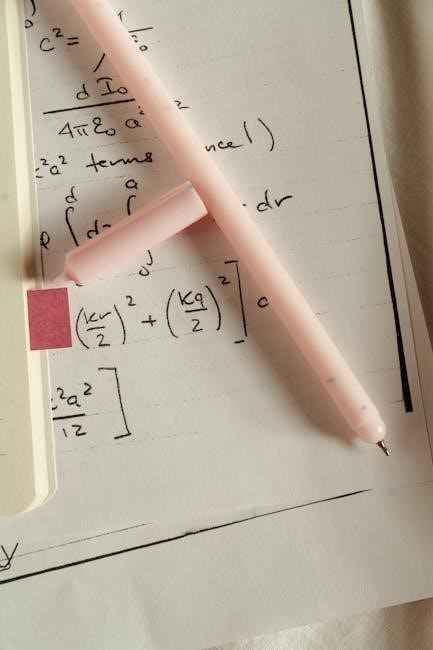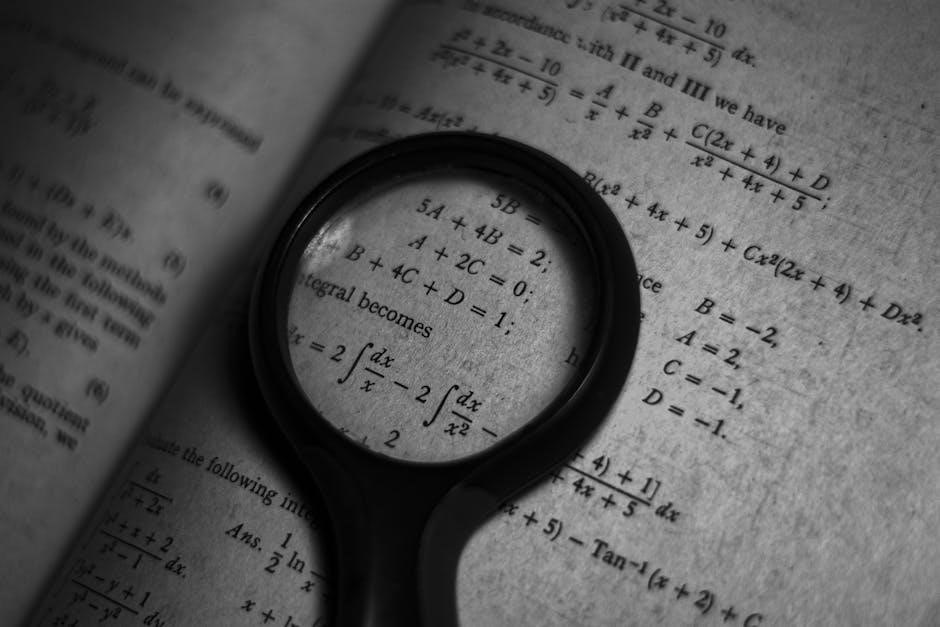This section provides a foundational understanding of differential equations and linear algebra, highlighting their interconnected role in modeling and solving real-world problems through mathematical analysis.

Overview of the Importance of Linear Algebra in Solving Differential Equations
Linear algebra plays a pivotal role in solving differential equations by providing essential tools such as matrices, vector spaces, and eigenvalues. These concepts enable the analysis of complex systems, breaking them into simpler, manageable components. For instance, systems of linear differential equations can be represented in matrix form, allowing for systematic solutions using techniques like eigenvalue decomposition. Additionally, linear algebra offers a framework for understanding the structure of solutions, including concepts like linearity and superposition. The interplay between linear algebra and differential equations is fundamental in fields like engineering and physics, where modeling real-world phenomena often requires solving systems of equations. This synergy ensures that solutions are both efficient and theoretically grounded, making linear algebra indispensable in advanced problem-solving.

Key Concepts and Terminology in Differential Equations
Differential equations involve fundamental concepts such as derivatives, which represent rates of change, and integrals, which accumulate quantities. Key terms include ordinary differential equations (ODEs), involving functions of a single variable, and partial differential equations (PDEs), involving multiple variables. The order of an ODE refers to the highest derivative present, while linearity indicates equations where variables and their derivatives appear to the first power. Homogeneous equations have no constant term, whereas nonhomogeneous equations do. Solutions may be general, covering all possibilities, or particular, satisfying specific conditions. These concepts form the backbone of analyzing and solving differential equations, essential for modeling various natural and engineered systems.
Systems of Linear Differential Equations
Systems of linear differential equations involve multiple equations with variables and their derivatives, often represented using matrices and vectors, requiring linear algebra for solutions.
Eigenvalues and Their Role in Solving Systems of Differential Equations
Eigenvalues are crucial in solving systems of linear differential equations, particularly when expressed in matrix form. They determine the stability and behavior of solutions, influencing growth, decay, or oscillations. By diagonalizing the coefficient matrix, eigenvalues simplify the system, allowing solutions to be expressed as combinations of exponential functions. In real-world applications, eigenvalues help model vibrations, electrical circuits, and population dynamics. Understanding eigenvalues is essential for analyzing resonance in mechanical systems and ensuring system stability in engineering designs. Their properties provide deep insights into the dynamic behavior of complex systems, making them a cornerstone of both theoretical and applied mathematics.
Applications of Linear Algebra in Modeling Real-World Problems

Linear algebra is a powerful tool for modeling and solving real-world problems across various fields, including engineering, physics, and economics. It provides methods to represent complex systems as matrices and vectors, enabling the analysis of multiple variables and their interactions. For instance, in electrical engineering, circuits can be modeled using systems of linear equations, while in economics, input-output models utilize matrix operations to study production processes. Additionally, linear algebra is fundamental in computer graphics for transformations and in machine learning for data analysis. Its applications extend to solving differential equations, where matrix exponentiation and eigenvalue problems are essential. This versatility makes linear algebra an indispensable framework for understanding and predicting the behavior of real-world phenomena, bridging theory with practical solutions.
Higher-Order Linear Differential Equations
This chapter explores higher-order linear differential equations, including second-order equations, and their applications in fields like mechanical vibrations and electrical circuits, emphasizing both homogeneous and nonhomogeneous cases.
Second-order linear differential equations involve the second derivative of a function and are fundamental in modeling various physical phenomena. These equations are characterized by their linearity and the presence of the second-highest derivative. They often arise in mechanical systems, such as mass-spring oscillators, and in electrical circuits involving inductors and capacitors. The general form of a second-order linear differential equation is ( y” + py’ + qy = f(x) ), where ( p ) and ( q ) are coefficients, and ( f(x) ) is a forcing function. Solving these equations typically involves finding the homogeneous solution and a particular solution. Techniques like the characteristic equation method and the use of damping and resonance concepts are essential for analyzing these equations, which play a crucial role in engineering and applied sciences.
General Solutions of Linear Differential Equations
The general solution of a linear differential equation combines the homogeneous and particular solutions. For homogeneous equations, methods like characteristic equations or eigenvalue problems are used to find complementary solutions. Particular solutions address non-homogeneous terms, employing techniques such as undetermined coefficients or variation of parameters. The superposition principle is key, allowing the combination of solutions to form the general solution. These solutions are vital in modeling oscillations, vibrations, and other dynamic systems. They often involve exponential, trigonometric, or polynomial functions, depending on the equation’s coefficients. Understanding these solutions is essential for analyzing and predicting system behavior in fields like physics and engineering.

Applications of Differential Equations and Linear Algebra
Differential equations and linear algebra are fundamental in modeling mechanical vibrations, electrical circuits, and other dynamic systems, providing essential tools for engineering and scientific analysis.
Mechanical Vibrations and Oscillations
Mechanical vibrations and oscillations are extensively studied using differential equations, primarily second-order linear equations. These equations effectively model various systems, such as mass-spring-damper setups, which are fundamental in mechanical engineering.
The integration of linear algebra, particularly through eigenvalues and eigenvectors, plays a pivotal role in solving these differential equations. This mathematical approach helps determine critical vibration characteristics, including damping ratios and natural frequencies. Furthermore, the concept of resonance, where an external force’s frequency matches the system’s natural frequency, is crucial. Understanding resonance is vital for preventing potential structural failures and optimizing system performance. Laplace transforms, derived from linear algebra, are instrumental in analyzing transient responses and steady-state behaviors in mechanical systems. The synergy between differential equations and linear algebra offers a comprehensive framework for predicting and controlling vibrational dynamics, which is essential for designing efficient and reliable mechanical systems across various industries, from automotive to aerospace.

Electrical Circuits and Networks
Differential equations and linear algebra are indispensable tools in analyzing electrical circuits and networks. These mathematical frameworks enable the modeling of circuit behavior, such as voltage and current dynamics, through systems of linear differential equations. Kirchhoff’s laws, which govern circuit behavior, are translated into mathematical equations that describe how electrical quantities change over time. Linear algebra is particularly vital for solving these systems, as it provides methods for handling matrices and vectors representing circuit components. Techniques like Laplace transforms further simplify the analysis of circuits by converting differential equations into algebraic forms. This combination of mathematical tools is essential for designing and optimizing electrical systems, from simple RLC circuits to complex power networks. The application of these concepts ensures efficient and reliable operation of electrical systems across various engineering domains.

